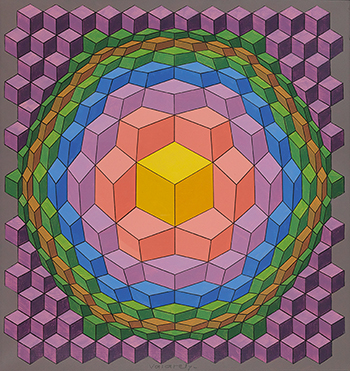PROVENANCE:
Fuji Television Gallery, Tokyo
Galerie Elegance, Taipei
Private collection, Asia
ILLUSTRATED:
Promenade à Paris , Galerie Elegance, Taipei, 2011, color illustrated, p. 190
This painting is to be sold with a certificate of authenticity issued by Fuji Television Gallery, Tokyo.
Catalogue Note:
FATHER OF OP ART
The term “Op Art” (Optical Art) derives from the exhibition “The Responsive Eye” that was held at the Museum of Modern Art in New York in 1965, which was the first large-scale exhibition to present to the public this new form of art, featuring precise compositions based on the use of scientific methods to analyze color, and on complex numerical calculations; works which, when viewed by the naked eye, often create optical illusions or a sense of movement. Following this exhibition, Victor Vasarely came to be universally acclaimed as the “Father of Op Art.”
Vasarely had in fact begun to create art 30 years before the beginning of this Op Art movement, one of the most influential art movements of the 20th century. Born in Hungary in 1906, Victor Vasarely enrolled in the department of medicine at Eötvös Loránd University in Budapest in 1925. Two years later, he decided to heed his calling to make art his career, and began academic art training. Vasarely’s medical training had instilled in him a markedly scientific approach, a commitment to objectivity, and an unslakeable thirst for knowledge. In 1929, Vasarely enrolled in the Mühely, an art school known as “Budapest’s Bauhaus,” where he was exposed to the work and theories of Malevitch and Kandinsky. He moved to Paris in 1930. “Zebra,” a monochrome painting that Vasarely created in 1938 (when he was 32), is generally considered to be the first Op Art work ever produced. The image is created from a pattern of rippling stripes, with no outline. With its perfectly juxtaposed contrast, the painting shows how simple lines can give two-dimensional space a sense of movement and dynamism.
Similar to Picasso, Modigliani, and other masters, he came from a foreign country and established a name for himself as an artist in Paris. Following the Renaissance, the limits of vision were explored once again, leading Western art into a new phase in which science and art became linked together. The former introduced new perspective methods before the viewer's field of vision, entering the painting at its vanishing point. Vasarely's concept involved how the flat plane of a painting could be protruded into a three-dimensional object and even create dynamic visual effects. At the same time, he opposed the creation of uncontrolled and random work in post-war abstract art. He adhered to the ruler, made measurements, and was never negligent in his calculations, successfully digitising the expressive forms of digital art. Inferring psychological implications from warm and cool tonal differences, his so-called ‘cold abstraction’ was actually filled with humanist thought and applications that reproduced natural geometric principles. In line with the trends of the times, Op Art made a quick sweep through the field of graphic design, and its influence has since continued to spread even further.
Vasarely was involved in the design and construction of more than 100 buildings and public art installations. In 1976, the Foundation Vasarely in Aix-en-Provence was inaugurated by French President George Pompidou. The Foundation buildings were designed by Vasarely himself; besides exhibiting Vasarely’s own works, the Foundation also undertook architectonic research. A Vasarely Museum was also opened in Vasarely’s birthplace of Pécs in Hungary in that same year. A further Vasarely museum opened in Budapest in 1987. The Fondation Vasarely in Aix-en-Provence is a museum that was founded over forty years ago. It is notable for its unique architecture, for which the French Government designated it a historic building in 2013. After six years of renovations, Fondation Vasarely will once again open its doors in the summer of 2018.
The 1989 work Körkép was originally titled in Hungarian, meaning panoramic view. Fixed at the centre of focus is an equilateral hexagon. There is the repetition of numerous rhombuses and differences in gradients of colour. Out of this is shaped a full cube, which has been continuously copied to form an archetypal hemispheric composition. The separate rhythms and orders in the work are spaced out while the colours and geometric figures are laid out to create a pulsing visual tempo that brings everything together in a symphonic image.
Vasarely has received numerous awards, including the Brussels Art Critics Prize, a Gold Medal at the Milan Triennial, and the Guggenheim Prize. His international reputation reached its apogee following the holding of the “The Responsive Eye” exhibition at the Museum of Modern Art in New York in 1965. In 1970, Vasarely was made a Chevalier of the Légion d’honneur by the French government. Many exhibitions of his work were held, and his pieces were avidly collected by major art museums all over the world. Having exerted a tremendous influence over the development of modern art in the 20th century, and having always been ahead of his time, the “Father of Op Art” died in Paris in 1997 at the age of 91, leaving behind an immense aesthetic gift for future generations.
